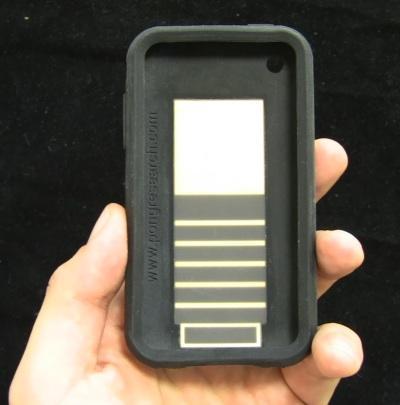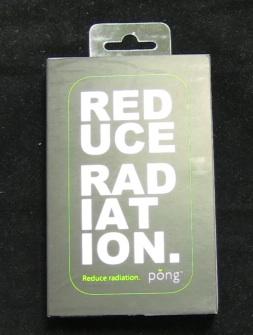
Pong Research makes an iPhone case that they say will redirect radiation from your phone away from your head, reducing SAR levels by over 60%. SAR stands for Specific Absorption Rate, and is the wireless industry's standard measure of how much RF energy (radiation) is absorbed by the body when using a mobile phone.
In other words, cell phones emit radiation. Some of that radiation gets absorbed into your body - specifically, into your head when you hold a cell phone up to your ear while using it. Pong claims their case cuts the amount of radiation that winds up in your body by more than half.
Whether or not radio waves emitted by cell phones are dangerous to humans is an oft-debated subject with no clear answer. Yet. It stands to reason that, over time, heavy cell phone users either will or won't develop cancer or other radiation-sourced illnesses. So far we've got studies commissioned by folks on both sides of the argument claiming to have definitively proved that cell phones are/aren't safe.

Given the fact that I use a lot of cell phones, get to review new products for my job, and don't much like the idea of a tumor in my head, I contacted Pong to hear about their work and give their iPhone case a whirl. At $59.95, Pong's case is quite a bit more expensive than your standard silicon iPhone jacket. But, really, if the thing works and ten years from now the other 49.999 million iPhone users all have brain tumors, sixty bucks will seem like a good deal, right?
The case itself is a pretty standard soft case. You get your choice of black or bright, bright green, and both models have a whole bunch of grippy dots - pips, you could call them - and a white "Pong" logo on the back. The name Pong, by the way, is a play on the word "ping." Ping as in "Ping-Pong" and ping as in how computers ping one another for data and people ping one another to communicate. So your Pong case keeps you safe from all of that radiation that your phone emits when it's pinging and being pinged. Get it?
Pong isn't the thinnest or sleekest silicon jacket on the market, but it's not too bad, and it's proved well-made and comfortable to use in the several weeks I've tested it on my iPhone 3GS. My phone fits easily into every dock and cable connector I've tried without the need to adjust or remove the case.
The case has cutouts for the camera sensor, silence switch, headphone jack, and bottom-edge dock port and speakers on the iPhone. Molded caps allow use of the side rocker and top lock buttons. No screen protection is afforded by the case.

The Pong magic is visible on the inside of the case's back panel. The "Pong technology module" is a rectangle-shaped, gold-color inlay that looks kind of like a silicon doodad of some sort. According to Pong, the module is "optimally aligned with the phone's internal antenna" to attract the radiative energy and move it up through the case and away from the user like a chimney moves smoke up and away from the fireplace in your living room.
Of course, I have no way of verifying whether or not the Pong case cuts down on radiation leaving an iPhone and entering my head. Nor do I have any way of verifying whether or not various types of cell phone-emitted radiation are, in fact, dangerous to my head (and the rest of my body). So this is where a potential purchaser of a Pong case has to take Pong's word for it, or not. Enter Pong's claims and the testing data they're using to back those claims up:
In 2002, the FTC conducted an investigation of numerous products claiming to reduce cellphone radiation. All claims were found to have no scientific basis. Pong is the first product to meet international testing standards for SAR reduction and has been verified by industry leading laboratory Cetecom to reduce SAR for the iPhone 3GS in the WCDMA 1900 band by over 60%.
CETECOM performs regulatory services required before release to the US, Canada, and European Union markets. Specializing in wireless technologies such as GSM, WCDMA, Bluetooth, and 802.11x, CETECOM provides radiated and conducted emissions and immunity testing for the following: Federal Communications Commission (FCC, Industry Canada (IC), R&TTE, CE Mark.
It's not just SAR levels that Pong claims to reduce with their tech, either. Electric Field Intensity drops 85% with a 3GS inside of a Pong case. And signal strength remains at a full 100% as compared to a non-Ponged iPhone. There's more where that came from on Pong's site.
Pong also had Wired Magazine out to the CETECOM facilities to verify their claims. And verify them, they did.

So while the jury is out on the link between cell phone use and cancer, it does kinda sorta really seem like Pong believes in what they're selling and has the best data available to back up their claims. Here's what the folks from Pong themselves have to say:
“Similar to smoking a cigarette,” says Dr. Alfred Wong, Pong's Chief Scientist, “one cigarette won’t kill you, but over years of exposure, the effect is cumulative. Many people are concerned about cell phone radiation, but out of necessity they continue to tolerate their own heavy usage. I think it’s a matter of balancing the fear against the need.”
"Much of the rest of the world is ahead of the US in terms of awareness of the radiation issue. This year the French government banned the use of cell phones in elementary schools because they recognized the risk to children's developing brains. When will Americans begin to take precaution against what is potentially a global public health hazard, with over 4 billion people using cellphones in 2010?"
The way I see it is like this: I have no proof that cell phones cause radiation-related health problems, but I wouldn't be surprised if they do. So if I'm going to bother keeping my phone in a case, may as well use a case that claims to reduce the potential harm of radiation and is backed by independent test data that proves some of that claim, anyway. I ordered a Pong case and keep my iPhone 3GS in it now. Of course, I don't always use the 3GS, and Pong doesn't yet make cases for any other devices. So I'm not totally in the clear, I guess.
Should you buy a Pong for your iPhone? I can't answer that for you. As a case it's good but not the best, and roughly twice as expensive as competitive silicon iPhone jacket. Style-wise, well, it's not super stylish but not unattractive, either. The black is pretty average looking and the green is downright radioactive in nature.
As for the health benefits of Pong, go with your gut. Nobody wants to wind up swindled out of their hard-earned cash, but nobody wants a brain tumor thanks to years of daily cell phone use, either. At least one friend of mine has already ordered her own Pong after seeing mine and asking about it. Honestly, I can't say I blame her.